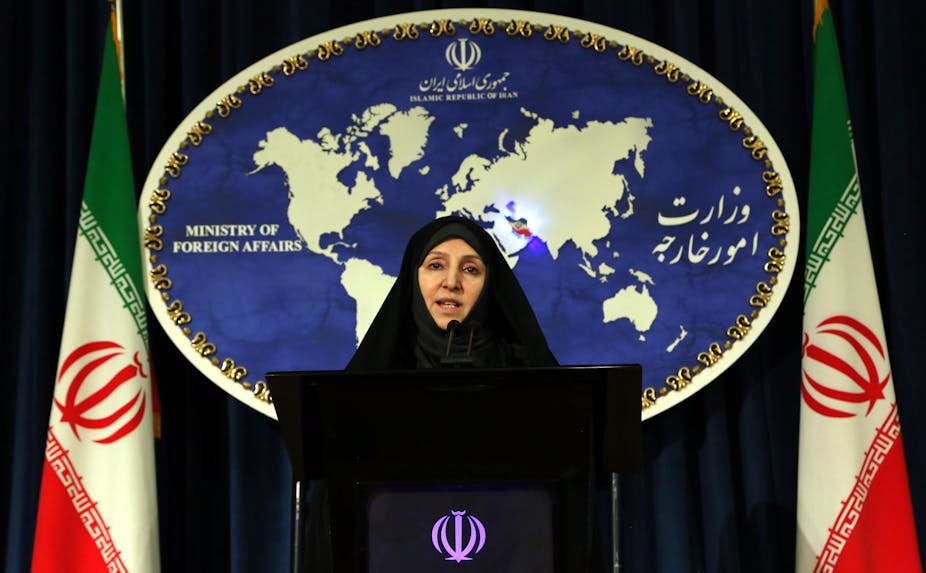Hassan Rouhani’s appointment of Marzieh Afkham as ambassador to East Asia is the first time such a prominent external role has been given to a woman since before the revolution.
The appointment has been seen by some as emblematic of the moderate stance taken by the president on social issues. Much western commentary on Iran assumes that being pro-women’s rights equates to being a political moderate, less Islamic and more pro-Western. However the complexity of politics in Iran confounds such analyses.
Women have historically played an important role in Iranian politics. Prior to the revolution, women participated in mass movements against dictatorship and colonialism and for social justice.
There is a history of women achieving high political office in Iran in both the pre and post-revolutionary periods. The reformist president Mohammad Khatami (1997-2005) appointed two women to high positions in his government – including Massoumeh Ebtekar as vice-president and Zahra Shojaee as presidential adviser and then head of the Centre for Women’s Participation.

Despite being seen as a consummate hardliner, it was Mahmoud Ahmadinejad, president between 2005 and 2013, who became the first leader in Iran’s history to appoint a woman to his cabinet. The participation of women in contemporary politics in Iran is due to the important role that women have played in politics since the revolution and the social changes that have taken place in the country.
Gender revolution
The Iranian revolution of 1979 led to the foundation of an Islamic Republic and radically changed the political landscape of the Middle East. For the West, which had installed and supported the brutal dictatorship of the Shah, it meant the loss of one of their primary allies in the region. For Iranians it was the beginning of the experiment of the Islamic Republic which claimed to fuse the principles of republicanism and national independence with Islamic principles of democracy and social justice.
During the next ten years Iranians experienced intense political repression during the disastrous war with Iraq in which the West armed and backed Saddam Hussein.
However, it was not the political repression but the social policies of the Islamic republic which were its most long-lasting legacy. The reforms of the Islamic republic – including free education, mass health programmes, availability of contraception and provision of social welfare – opened the way for mass participation of women in society and politics.

Today, levels of literacy are higher in Iran than in many other countries in the region. Women in Iran have more rights than in neighbouring US-backed states, they have a strong presence in the workforce, in politics, are highly educated and make up 65% of all students entering university.
Since the 1990s Iran has witnessed a huge growth in movements calling for democratic, legislative and socio-political reform. Opposition to the policies of the state has come from both secular groups and organisations and Islamic reformers who feel that Islamic values and principles have been abandoned by the political elites.
The mid-1990s was marked by the emergence of Islamic feminism and the women’s movement as important social forces in Iran. The economic and political reforms under the first decade of the revolution encouraged women’s education and participation in the workforce. A generation of highly educated, economically independent religious women had high expectations from a government which claimed to be run according to Islamic principles. They formed the backbone of a movement that won significant legislative and political victories in the 1990s and early 2000s.
Neo-liberalism a feminist issue
However, since the 1990s, every government, whether it identified as left or right, conservative or reformist, has enacted neo-liberal economic policies which have dismantled the social welfare programmes set up after the revolution. Since 2010, the government has dismantled subsidies on gasoline, water, electricity, rice, flour, bus fares and university tuition causing an enormous rise in inflation and the cost of living.
Alongside this the welfare programmes of the state have been cut back as the government of Ahmadinejad amended article 44 of the constitution in order to privatise the public sector. Rouhani has continued these policies, which have led to increased unemployment, particularly among university graduates and increased poverty.
In Iran, as in other countries, neo-liberal policies affect women more – as it is women who bear the burden of looking after the old, the sick and the young and who work in lower-paid, more casualised and more insecure employment.
While Rouhani’s statements in favour of equal opportunities for women are to be welcomed, we need to move beyond simplistic analyses of the country that views this as a breakthrough for women carried out by moderate liberals against religious hardliners. In particular we need to recognise the impact of the international economic and political system on women in Iran and elsewhere.
Despite espousing concern for women’s rights, it is the economic policies of international agencies such as the IMF and the World Bank and the policies of western governments that have isolated Iran economically eroded the ability for a new generation of women to participate in politics in Iran.

